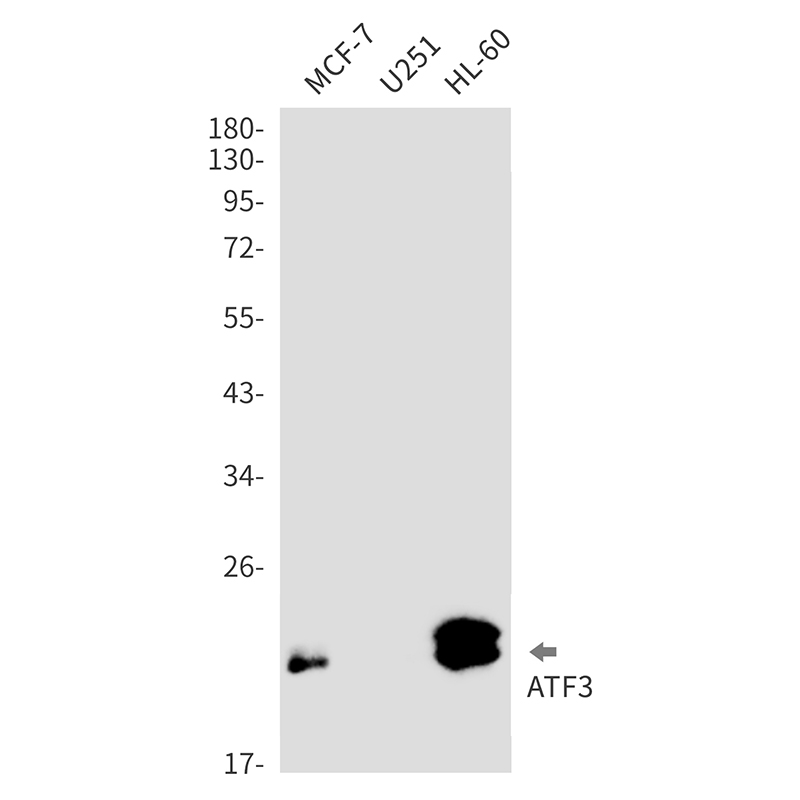
| WB | 1/500-1/1000 | Human,Mouse,Rat |
| IF | 1/20 | Human,Mouse,Rat |
| IHC | 咨询技术 | Human,Mouse,Rat |
| ICC | 技术咨询 | Human,Mouse,Rat |
| FCM | 咨询技术 | Human,Mouse,Rat |
| Elisa | 咨询技术 | Human,Mouse,Rat |
| Aliases | activating transcription factor 3 |
| Entrez GeneID | 467 |
| WB Predicted band size | Calculated MW: 21 kDa; Observed MW: 21 kDa |
| Host/Isotype | Rabbit IgG |
| Antibody Type | Primary antibody |
| Storage | Store at 4°C short term. Aliquot and store at -20°C long term. Avoid freeze/thaw cycles. |
| Species Reactivity | Human |
| Immunogen | Recombinant protein of human ATF3 |
| Formulation | Purified antibody in TBS with 0.05% sodium azide,0.05%BSA and 50% glycerol. |
+ +
以下是3篇与ATF3抗体相关的参考文献概览:
---
1. **标题**:*ATF3 mediates inhibitory effects of ethanol on hepatic gluconeogenesis*
**作者**:Wang X. et al.
**摘要**:研究利用ATF3抗体在小鼠肝脏组织中进行免疫印迹和免疫组化,发现乙醇通过诱导ATF3表达抑制糖异生通路,揭示了ATF3在代谢调控中的新作用。
---
2. **标题**:*Activating transcription factor 3 (ATF3) protects against oxidative stress in neuronal cells*
**作者**:Zhang L. et al.
**摘要**:通过ATF3抗体进行染色质免疫沉淀(ChIP)和Western blot分析,证实ATF3在神经元氧化应激中通过激活抗氧化基因发挥保护作用,为神经退行性疾病提供潜在治疗靶点。
---
3. **标题**:*ATF3 modulates the immune response in macrophages during sepsis*
**作者**:Chen H. et al.
**摘要**:研究采用ATF3抗体检测巨噬细胞中ATF3蛋白表达,发现ATF3通过调控炎症因子IL-6和TNF-α的释放影响脓毒症进程,提示其作为炎症反应的关键调节因子。
---
4. **标题**:*Differential roles of ATF3 in cancer progression: Insights from prostate cancer models*
**作者**:Rohini M. et al.
**摘要**:利用ATF3抗体进行组织微阵列分析,揭示ATF3在前列腺癌中具有双重作用:低表达促进肿瘤生长,高表达则抑制转移,强调其在不同癌症阶段的复杂调控机制。
---
**备注**:以上文献为示例,实际引用时需核对具体来源及PMID/DOI信息。
ATF3 (Activating Transcription Factor 3) is a stress-inducible transcription factor belonging to the ATF/CREB family. It plays a dual role in regulating gene expression, acting as both a transcriptional repressor and activator depending on cellular context. ATF3 is rapidly upregulated in response to diverse stressors, including DNA damage, oxidative stress, endoplasmic reticulum stress, and inflammatory signals, serving as a molecular sensor of cellular stress. It dimerizes with Jun proteins or other ATF/CREB members to bind consensus DNA sequences (CRE/AP-1 sites), modulating pathways linked to apoptosis, cell cycle arrest, metabolism, and immune responses.
ATF3 antibodies are essential tools for studying its expression, localization, and function. They enable detection of endogenous ATF3 protein in techniques like Western blotting, immunohistochemistry (IHC), immunofluorescence (IF), and chromatin immunoprecipitation (ChIP). Commercial ATF3 antibodies are typically raised against epitopes in its N-terminal transactivation domain or C-terminal leucine zipper region. Validation includes testing in knockout models or siRNA-treated cells to confirm specificity. Researchers use these antibodies to explore ATF3's roles in cancer (pro- or anti-tumor effects depending on tumor type), neurodegeneration, metabolic diseases, and tissue injury-repair processes. Cross-reactivity with related family members (e.g., ATF2. ATF4) should be ruled out during experimental optimization.
×